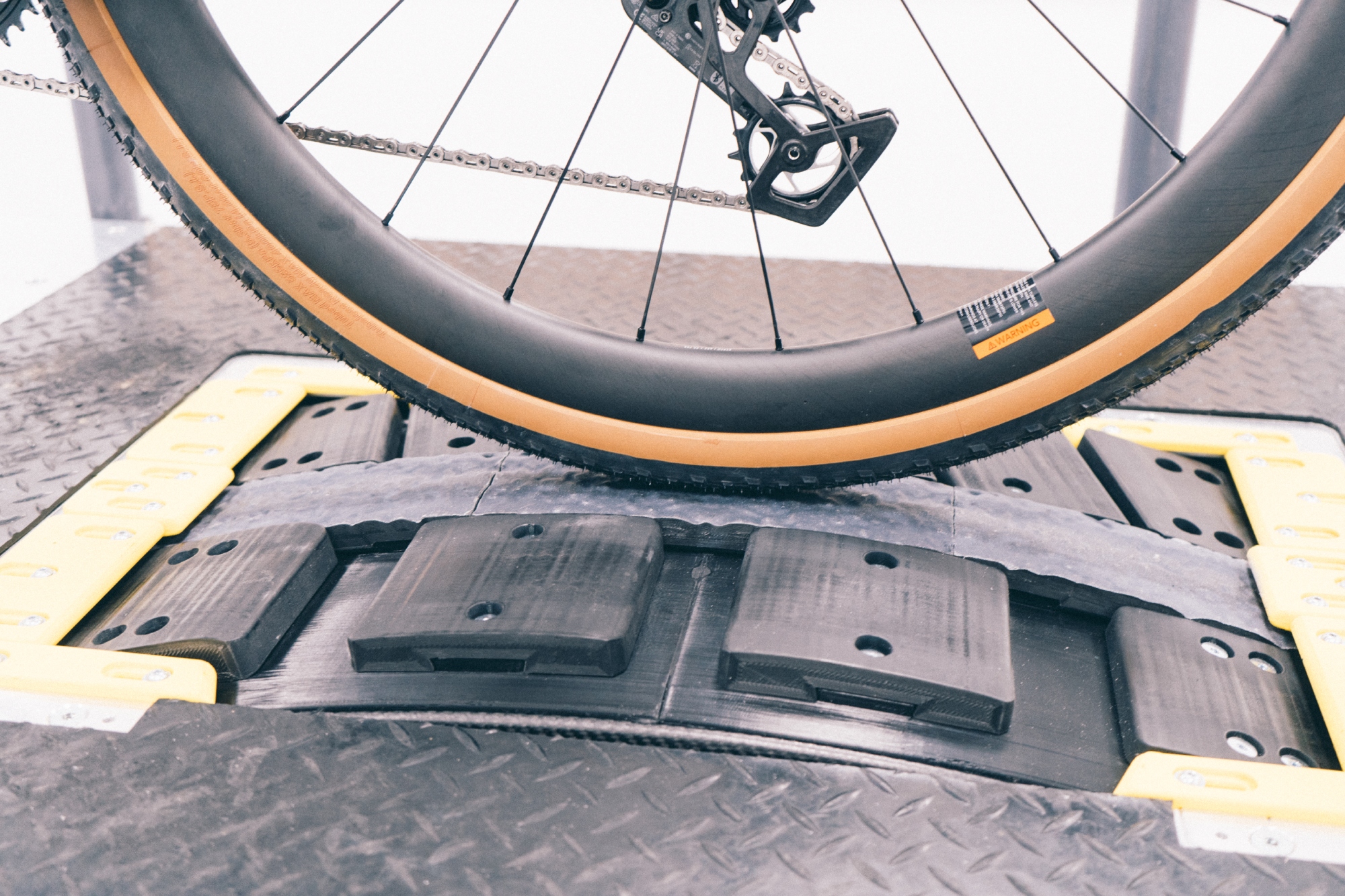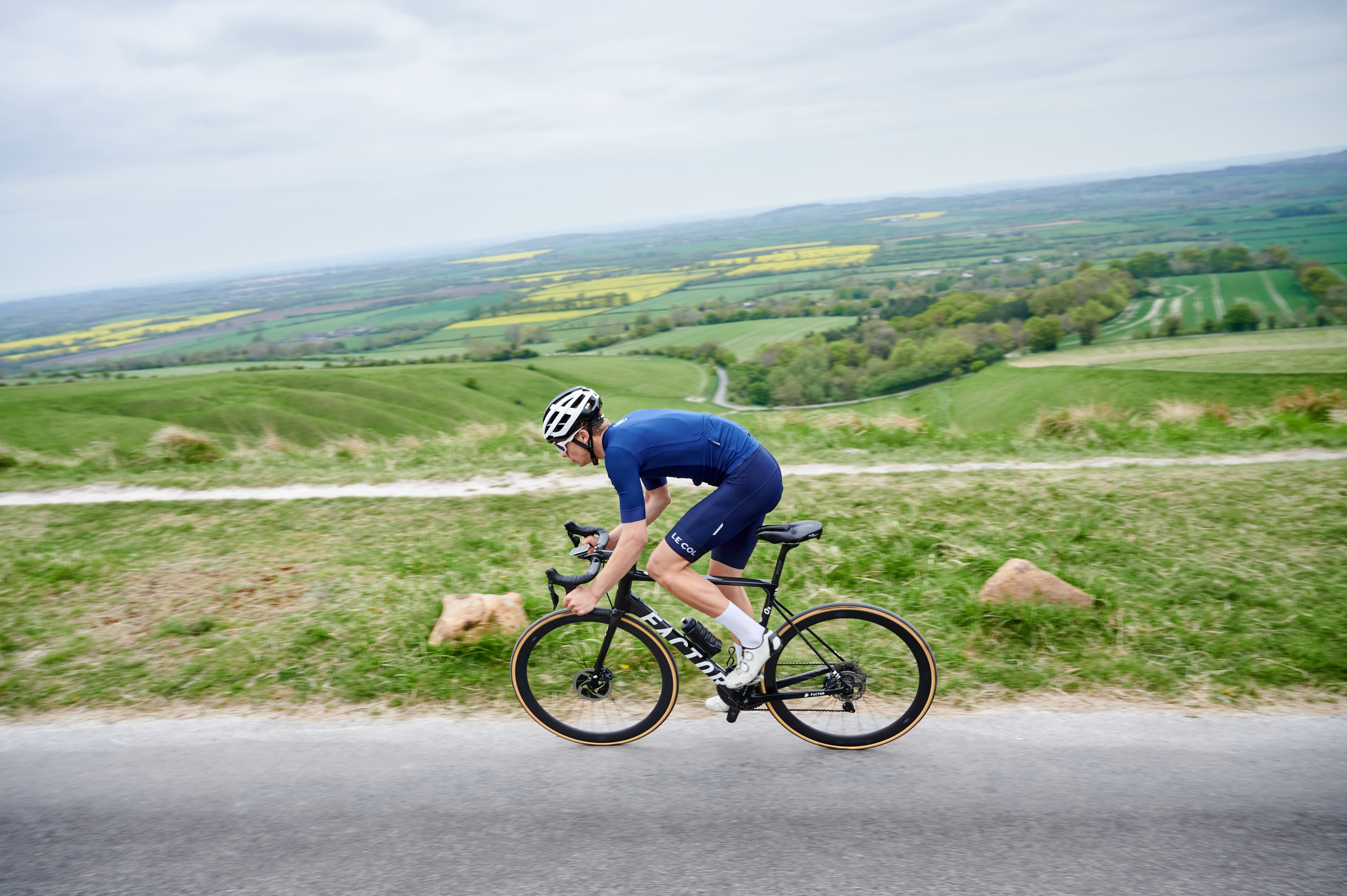Within the quest for growing the quickest tyre, rolling resistance is among the most talked-about, and misunderstood, metrics in biking. On the root of this obsession is a deceptively easy query: which tyre is quickest? Extra particularly, how a lot power is required to roll a tyre over a floor?
The reply lies in rolling resistance, or extra exactly, the coefficient of rolling resistance (Crr), which is a posh measure influenced by tyre strain, pace, highway texture, rubber compound, rider weight and extra.
Regardless of advances in expertise, the biking trade continues to measure rolling resistance the identical method it has for many years now: the metal drum check. This method includes spinning a wheel and tyre towards a {smooth} metal cylinder whereas measuring the ability required to maintain it transferring. It’s a managed, repeatable approach to quantify one key supply of vitality loss brought on by the deformation of the tyre casing, referred to as hysteresis loss.
Tyre corporations designing and testing merchandise can use curler exams to match tyres towards one different with no need to bear in mind the plethora of environmental variables launched by out of doors testing. And, on a totally {smooth} floor, like a velodrome, this testing correlates moderately nicely.
However the world will not be surfaced like a velodrome.
On precise, paved roads (to not point out unpaved) issues get much more complicated. A metal drum can measure hysteresis, however it doesn’t replicate one other main facet of rolling resistance, referred to as impedance or suspension losses. Within the phrases of Silca’s Josh Poertner, these are “the losses because of the bouncing, jostling, and vibrational losses launched into the remainder of the bicycle/rider system by highway vibrations.”
Poertner, who has labored extensively with World Tour groups to assist them higher perceive the right way to optimise their gear, explains these two concerns thusly: “When you plot Crr on a drum check, you’ll discover that Crr decreases asymptotically as strain will increase. Nevertheless, when you plot Crr in subject testing, you see that there are two distinct regimes of Crr, the primary one dominated by casing losses, and the second dominated by impedance losses. Drum testing is simply helpful in predicting the regime dominated by casing losses.”
The newest race content material, interviews, options, evaluations and skilled shopping for guides, direct to your inbox!
In different phrases: drum testing fails to seize this second class of losses solely. It tells solely a part of the story.
That is to not say that drum testing is not helpful. Based on Poertner, drum testing can definitely assist in “predicting the relative variations between tyres. So the drum will probably be a poor predictor of precise Crr on any non-smooth floor, but when tyre A is 3% sooner on the drum than tyre B, it will likely be very shut to three% sooner on actual world surfaces.“
However even right here, in discerning how tyres carry out relative to at least one one other, there are limitations.
A further difficulty with drum testing is that the scale of the drum skews how completely different tyres carry out. A small diameter drum measures extra hysteresis loss on tyres at decrease pressures or with extra tread merely because of the drum form, which digs into the tyre in a method that precise using surfaces don’t. Roads are fairly flat, comparatively, and a curler drum would should be huge in an effort to precisely replicate this.
Since drum testing solely reveals one facet of losses, greater pressures seem to have decrease rolling resistance. And, for a very long time, this was the prevailing perception in biking. We now know this to be false. Relating to precise, actual life surfaces, decrease pressures cut back impedance losses, which turn out to be extra vital as surfaces get bumpier.

(Picture credit score: Will Jones / Biking Information)
Options to drum testing
Since actual world testing has such a excessive variety of elements to contemplate, similar to climate variability, floor modifications, rider fatigue, and so on. getting correct outcomes is hard. All of those elements make this testing far more costly and time consuming than drum testing.
Poertner’s most well-liked testing technique is known as the Chung Technique, also called Digital Elevation Testing.
“It is an effective way to foretell Crr in subject testing, and has confirmed invaluable in optimising setups for each gear selection, in addition to discovering optimum tyre strain for a given floor,” says Poertner. “This technique has the advantage of being helpful on the precise surfaces you wish to check.”
The fundamental premise of the Chung Technique is to journey a brief, stop-free course a number of occasions at quite a lot of energy outputs (an influence meter is critical, as is a approach to precisely measure pace and altitude achieve). Additionally it is crucial to check on a day with out wind. By repeating this check with completely different tyres, one can isolate the true coefficient of rolling resistance of every tyre on the floor at hand.
This model of testing additionally might be helpful for making aerodynamic enhancements to at least one’s setup, however the powerful half is that it’s usually very rider and circumstances particular. Like aerodynamic optimisation, what works for one individual could or could not work for others. Additionally, gravel races would not have constant surfaces—among the race is perhaps paved whereas different elements is perhaps extraordinarily rugged. Riders must determine which a part of the course to prioritise their gear for, making educated guesses as to what tyre and tyre strain will present the most suitable choice for his or her hoped-for racing or using outcomes.
One other testing approach is the roll down check, whereby a rider repeatedly rides down a hill with tightly managed variables in an try and isolate the tyre’s losses. This testing methodology is straightforward, however requires very particular circumstances in an effort to discover efficient outcomes. The profit is that it removes among the extra variables current within the Chung technique.
A super situation, with the last word management over testing variables, could be to carry an out of doors floor indoors. That is theoretically possible, however would take immense sources in an effort to be realised. One thing related is being finished within the Catesby Tunnel within the Northamptonshire countryside in England for testing aerodynamics (extra about that right here). Possibly if all of us write the Catesby Tunnel Check Facility a letter they’d be prepared to floor one half of the highway with gravel from Emporia, Kansas? I’ll be the primary one in line if it occurs!

(Picture credit score: Future)
Conclusion
Determining a tyre’s true rolling resistance is something however easy.
Whereas curler drum exams supply a handy approach to evaluate tyres in managed settings, they solely inform a part of the story. Actual-world strategies just like the Chung Technique or roll-down testing can get us nearer to the reality, even when they arrive with their very own challenges. There’s no good resolution simply but. However as our understanding (and our roads) evolve, so too will the methods we measure what actually makes a tyre quick.
